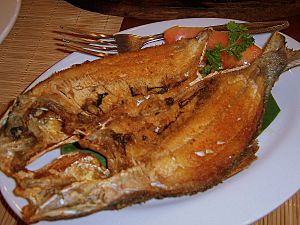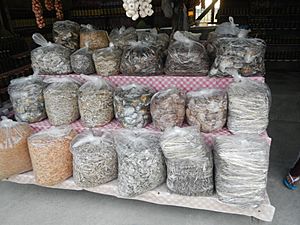Daing facts for kids
 |
|
| Alternative names | Bilad, Tuyô, Pinikas |
|---|---|
| Place of origin | Philippines |
| Variations | Labtingaw, lamayo |
Daing, also known as tuyô or bilad, is a popular type of dried fish from the Philippines. The word "daing" means "sun-dried" or "sun-baked."
To make daing, fish are usually cut open and cleaned. Then, a lot of salt is added to them. After salting, the fish are left to dry in the sun and air. This process helps to remove water from the fish. Removing water and adding salt stops tiny germs from growing. This way, the fish can be kept for a long time without spoiling. Some daing is even made "boneless" by removing the bones before drying.
People usually fry or grill daing before eating it. You can also bake it in an oven wrapped in foil. It is often eaten for breakfast with white rice. Many people like to dip it in vinegar. A special way to enjoy daing is with champorado, which is a traditional Filipino chocolate rice porridge. Daing can also be an ingredient in other dishes.
Even though daing is usually inexpensive, it is a very important food in Filipino culture. It is often seen as a comforting food that reminds people of home.
How is Daing Made?
Almost any kind of fish can be turned into daing. When you buy daing at the market, it is usually named after the type of fish used. For example, in Cebu, a popular daing is made from rabbitfish. This fish is known as danggit there, so the daing is called buwad danggit.
Other common fish used include threadfin breams, called bisugo. Grey mullets, known as banak, are also used. Sardines, like tunsoy or tamban, are often made into daing too. Sardine daing is usually dried whole. However, if it's sent to other countries, it might be cleaned first. Even cuttlefish and squid can be prepared this way. In the Tagalog language, it's called daing na pusit. In Cebuano, it's bulad pusit.
In the central and southern parts of the Philippines, daing is known as bulad or buwad in the Cebuano language. When the fish is sliced and cleaned before drying, it is called pinikas. This word means "halved," referring to the fish being cut in half. In northern areas, people often use "daing" for all types. But some might use "daing" only for the halved fish and "tuyô" for all other kinds of dried fish.
Different Kinds of Daing
There are a few special types of daing:
Labtingaw
Labtingaw is a type of daing that uses less salt. It is also dried for a much shorter time, only a few hours. Because of this, labtingaw is still a bit moist and has more meat than fully dried daing.
Lamayo
Lamayo is another type of daing that skips the drying process completely. After the fish is cleaned, it is simply soaked in a mix of vinegar, garlic, and other spices. Then, it is ready to be fried and eaten.


